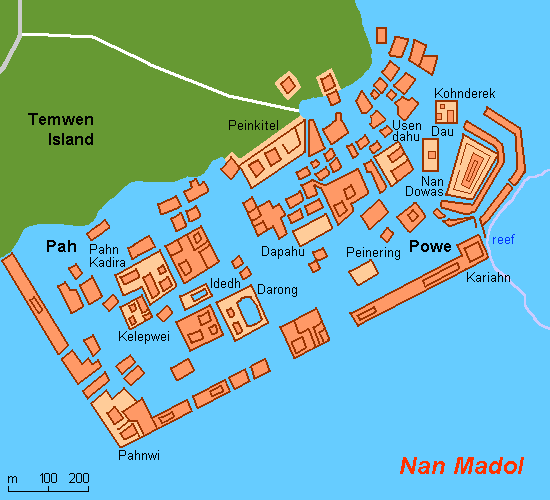In a remote region of the western Pacific, just north of the equator, lies the ruins of the ancient and enigmatic city of Nan Madol. The magnificent ruin, built in a lagoon on the east side of Micronesian island Pohnpei, consists of 92 artificial islets constructed on coral reefs which are linked by a network of canals, giving it the nickname Venice of the Pacific.
Nan Madol is an engineering wonder, with massive basalt walls reaching 16 meters high in some places. Carbon dating indicates the structures are around 900 years old, but the islets themselves date even further back to the 8th and 9th centuries AD. The basalt stones originated on the opposite side of Pohnpei from a volcanic plug, where magma had hardened within the vent of an active volcano. What has modern archeologists mystified is how these massive stones were moved from one side of Pohnpei to the other using what primitive technology would have been available at the time. Furthermore, once the basalt had been successfully transported, it would have then been hoisted to heights of 16 meters. The effort required to build the megalithic structures would have rivaled that of the Egyptian pyramids, with a total area of 75 hectares, and an estimated total weight of 750,000 metric tons.

Photo: NOAA
Experts have suggested that the giant rocks may have been transported to the coral islands making up Nan Madol with the help of rafts, but they have yet to come up with a theory for how they were originally moved from their distant quarries and used to erect impressive structures. Its location, so far away from civilization, is also a mystery.
“Why would somebody build a city out on the middle of the ocean? Why here, so far away from any other known civilisation?” Dr Patrick Hunt, archaeologist, told Science Channel series ‘What on Earth?’

Photo: Hobe
“There’s something strange going on off the coast of the Micronesian island of Ponhpei,” explorer George Kourounis recently said. “There are these tiny islands almost 100 of them that are remarkably similar and geometrically shaped. The reason? It’s not so clear.”
Mythology offers an explanation where science fails, as according to Pohnpeian legend the city was constructed by twin sorcerers Olisihpa and Olosohpa. The brothers sought a place to build an altar so that they could worship Nahnisohn Sahpw, the god of agriculture. They performed rituals to levitate the massive basalt into the form of Nan Madol. Olosohpa eventually became the first Saudeleur, the dynasty that went on to rule Nan Madol until about 1628. Their reign ended with the invasion by the legendary warrior Isokelekel, who also resided at Nan Madol, and implemented the Nahnmwarki system of a tribal chiefdom, which continues into the modern era. Most Pohnpeians still believe that the ancient city was the work of sorcery.

Photo: CT Snow
However it came to be, it is known to have been a sacred site founded by The Saudeleur dynasty, and populated by chiefs and priests, as well as commoners to serve them. The Saudeleur rulers required local nobility to reside in the city as a means to monitor their activity and maintain control. The subjugated Pohnpeians brought food and water to the city, as there were no means to grow food or collect water on the reef. It was this logistical problem that may have eventually led to the abandonment of this incredible city.
The mystery of the ancient city’s existence and purpose has also inspired some legends of spirits and ghosts, making it a scary place to visit for most, despite its UNESCO World Herritage status. While similar sites receive hundreds of thousands of visitors every year, only around 1,000 tourists come to Nan Madol, many of them ghost hunters.
In 1985, Nan Madol was designated a National Historic Landmark by the U.S. Interior Department, the only such site in the Federated States of Micronesia, and in 2016 it was added to the list of UNESCO World Heritage sites. The ruins are threatened by encroaching mangroves, as well as the temperamental Pacific weather, earning it a place on the World Heritage in Danger List as well.*






